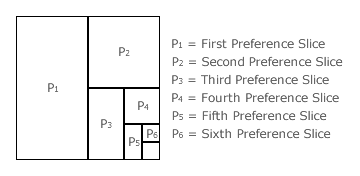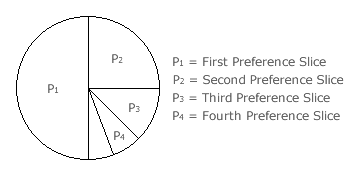Description: Analogy (A Piece of Cake)
Before stating the formal definition of GV in general and CHPV in particular, imagine voters are given a cake each and asked to award candidates different amounts or slices of it to reflect their preference for each candidate. Using ranked ballot CHPV to elect one candidate from six, the square cake shown below would be shared as follows.

Initially, each voter cuts their own cake exactly in half and gives their chosen first preference candidate one half. The remainder of the cake is again cut into two exactly equal slices with one half now going to their second preference. This process of halving the remainder and giving half of it to the next-preferred candidate is continued until they wish to stop or every candidate gets some slice of the cake. Once the voters have awarded their slices, the candidate with the most cake wins the election.
Notice that there is no limit to the number of candidates that can stand for election. For every expressed preference, the relevant candidate gets an appropriately sized slice. If, for any reason, a voter does not wish to express any preference for one or more candidates, they may do so by not awarding any slice at all to such candidates.
If two winners were required rather than just one, then the two candidates with the most cake would both be elected. CHPV and GV elections can be used to elect one or more winners as they simply convert the set of individual voter preferences into one group or overall rank order from which the top one or ones are elected.
Using GV instead of CHPV just means cutting the cake into different sized slices. Rather than cutting the initial or remaining cake in half, the fraction may vary between zero and one. Suppose a fixed fraction of one third is adopted. A first preference candidate would then get a one-third slice, a second preference one would get one third of a one-third slice (a one-ninth slice), a third one would get one third of a one-ninth slice (a one-twenty-seventh slice) and so on. For fractions under one half, there will be cake left over. For fractions over one half, more than one cake per voter would be needed at the outset.

Obviously, real voting is done on paper or electronically. However, even with this illustrative cake analogy, one key property of CHPV is already apparent. By adding one half, one quarter, one eighth, one sixteenth and all possible further slices without limit then the sum total is clearly the one original whole cake as there would be no remainder left.
For the range of GV systems, it is only true for CHPV - with its common ratio of one half - that each preference is worth the same as the sum to infinity of all lower preferences. These relationships can clearly be seen in the CHPV cake figure above or, for an alternative round 'pork pie' analogy, the pie chart opposite. This is the key aspect that gives CHPV its special features and critical properties.
For party-list CHPV, the cake or pie for each party is now analogous to the total number of votes it receives. The more votes it gets, the bigger its cake and the larger each candidate slice becomes. Regardless of the size of each party cake, the slices must still be cut and shared out amongst its own candidates in proportion to the common ratio of one half. So each candidate gets twice the size of slice that the next-ranked candidate in that party gets. Irrespective of party affiliation, those candidates with the most cake are elected to fill the vacant positions.
Proceed to next section > Description: Weightings
Return to previous page > Description: Introduction
